China rose: care and growing from seeds
 China rose plant, or Chinese hibiscus (lat. Hibiscus rosa-sinensis) is one of the most popular species in the culture that belongs to the genus Hibiscus and family Malvaceae. Hibiscus genus includes about two hundred species, but Chinese hibiscus has become the most popular in home horticulture. The flower of China rose is native to the south of China and the north of Indochina from which it began its triumphant spread over subtropical and tropical regions of the Earth.
China rose plant, or Chinese hibiscus (lat. Hibiscus rosa-sinensis) is one of the most popular species in the culture that belongs to the genus Hibiscus and family Malvaceae. Hibiscus genus includes about two hundred species, but Chinese hibiscus has become the most popular in home horticulture. The flower of China rose is native to the south of China and the north of Indochina from which it began its triumphant spread over subtropical and tropical regions of the Earth.
The popularity of this plant is so great that in Malaysia, for example, Chinese hibiscus called Bunga Raya is one of the country's symbol depicted on coins. In countries where the climate is not favorable for China rose it is cultivated as a hothouse or indoor plant.
Description of China rose
Indoor China rose is an evergreen shrub or a tree up to 10 ft in height if it is grown in a hothouse, and up to 6.5 ft if it is grown in a flat. The leaves of the plant resembles birch leaves: smooth, shiny, dark green, serrated on the edge, ovate. Solitary flowers are very beautiful: when opening narrow buds are similar to the broad cup with the diameter of 3 to 5.5 inches. The flowers can be simple or double depending on the varieties. The colors of flowers are white, yellow, red or pink. Unfortunately, each flower blooms only one or two days, but if you care for China rose properly, flowering can last from early spring to late autumn. Sometimes China rose is grown at home as a rose-tree. China rose is not only a beautiful ornamental plant: at the places of its natural growth, its young shoots are served as a salad, the flowers are used to make the hair dye and food products, and dried hibiscus fruits are ingredients of well-known medical teas (“Hibiscus tea”, “Sudanese Rose”, etc.).
Growing of China rose from seeds
How to grow China rose from the seeds
Garden lovers do not like the seed breeding of perennial plants preferring more reliable and faster way of vegetative breeding. But China rose is easily propagated by seeds and by cuttings due to excellent germination qualities. The simplicity of the procedure makes the seed method of propagation exciting and productive. It should be noted that the seeds of China rose remain viable for six years.
In late February, before planting, the seeds should be soaked in a pink solution of potassium permanganate for disinfection for a half-hour, then they are thoroughly rinsed and soaked again in a solution of growth stimulator for a day (the liquid should slightly cover the seeds, otherwise the lack of oxygen will kill the germs). The seeds are germinated in a moist gauze that should be unwrapped for ventilation from time to time.
Heat and moisture are the main factors for the germination of China rose, therefore, place a wet gauze with the seeds in a plastic bag with perforation for the seeds to get air. When the shoots appear, and this is to be expected in about three days, they will need to be repotted in an 18 fl oz plastic cups with a mixture of sand, peat and ashes: it is very important for the long taproot of the plant to grow freely, without curving and twisting. The seeds should be slightly covered with the soil, and then the cups are covered with foil or paper. For the seedlings not to be affected by "blackleg" disease, they should be processed with a weak solution of fungicide and further watering should be moderate. For successful growth seedlings require a bright diffused light, but not a direct sunlight.
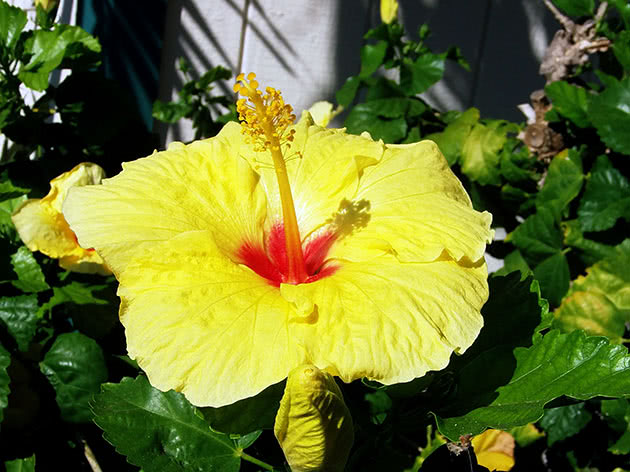
Care for China rose at home
How to care for China rose
For China rose find a bright place near the window protected from a direct sunlight. If you put it in the shade, it may refuse to bloom. During warmer months, it is highly desirable to place the plant outdoors avoiding drafts and scorching sun. In summer, a comfortable temperature for China rose is 64-77 ºF and higher. In winter the temperature should not be less than 59 ºF. The lowering of the temperature up to 50 ºF can make the plant drop off the leaves. Growing of China rose requires a high humidity, so spray the leaves of the plant in the summer heat and even in winter, if the room temperature is higher than it is necessary for the plant at this time of the year. A warm shower can be useful as it helps not only nourish the leaves with moisture, but also get China rose rid of the spider mite, but try to avoid dripping on the flowers and buds as it makes them spotty and fall off. You can use a proven way of humidification: put a plant on a tray with wet pebbles or expanded clay, but the bottom of the pot with China rose should not be in water. Care for China rose at home also implies arranging of an adequate watering and applying of a proper fertilizer. The plant is watered with a sedimented water of a room temperature, and the frequency is determined by drying of the topsoil at a depth of 0.8-1 inch. Feed China rose with a fertilizer for flowering plants or alternate combined mineral fertilizer with organic fertilizer every two weeks in the period from April to September. In winter, only potassium and phosphorus fertilizers are applied in the amount of a quarter of the indicated dose, and only in case of rose flowering.
Pruning of China rose
Many novice gardeners ask when China rose needs pruning. Pruning is carried out in spring before transplanting of the plants and before the formation of buds. The purpose of pruning is increasing the number of flowering shoots, promoting of the flowering and the formation of a lush bush. How to prune China rose? It is necessary to remove dried, stretched and bared shoots and to shorten healthy shoots by half. The places of cuts are processed with petrolatum ointment to stop the flow of sap from the sore. The cut shoots can be used as cuttings for rooting. If your goal is rejuvenating of the adult plant, cut all the shoots at a height of 6 inches from the ground, provided that at least one bud is left on this segment. When young shoots start growing, remove the weakest shoots and keep only healthy branches. In summer, carry out one more pruning and you will get the flower buds on the regrown branches only at the beginning of autumn, and you will be able to enjoy the beautiful hibiscus flowers until spring.
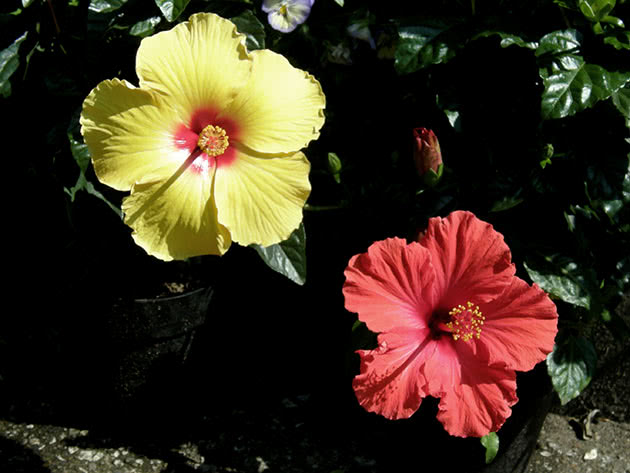
China rose in a pot
The pot for China rose should be rather small since in a large pot China rose will rapidly increase the amount of leaves, but it will not bloom. Each subsequent pot must be 0.8-1 inch bigger in diameter than the previous one. Young plants are transplanted each year, and the plants that have reached the age of five are repotted once in 3-4 years. The old, but healthy plants are not transplanted, but every year the topsoil should be refreshed at the depth of 0.8-1 inch.
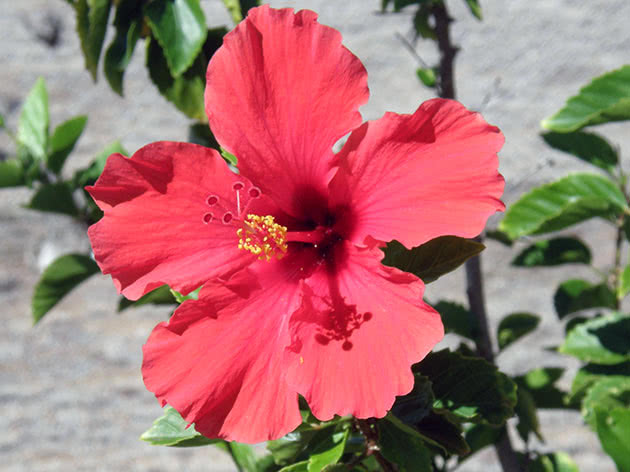
Transplanting of China rose
How to plant China rose? At first, prepare a mixture of turf, leaf soil (one part of each), humus soil and sand (a half part of each), and it is also desirable to add one part of peat soil in the mix for the young plants. And, of course, place a layer of expanded clay, broken bricks or clay shards on the bottom of the pot for the moisture not to stagnate in the roots of the plant. How to transplant China rose not to damage the root system of the plant? You should transplant China rose from the old pot to a new one with a clod of soil.
China rose after flowering
China rose does not have a dormant period as such, or at least a distinct dormant period. But still you can make your plant rest by gradually reducing watering to the necessary minimum. As soon as the leaves fall off, the plant is pruned, leaving 6 inches of shoots from the roots, and placed in a partial shade at a temperature of 50-54 ºF for winter. From time to time China rose is watered, and then it is covered with a mat or paper bag to keep moisture in the soil as long as possible. In spring the pot with a plant is exposed to a bright diffused light and watering is gradually increased to the usual amount to promote the growth of young shoots.
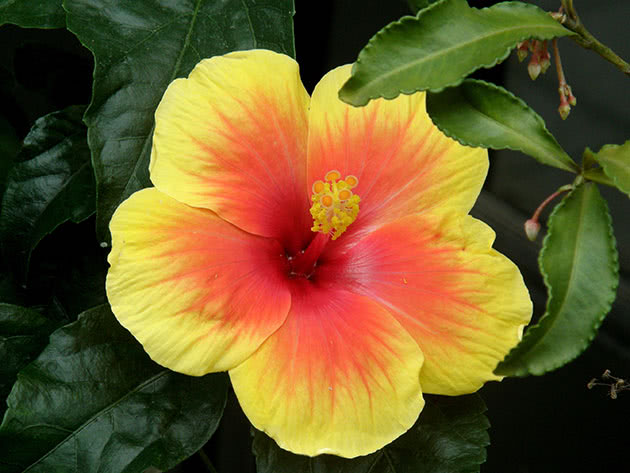
Propagation of China rose at home
As we have already noted, China rose is well propagated by seeds. How to propagate China rose vegetatively, for example, by cuttings? The cuttings of China rose that are left after spring pruning are the best for rooting. Treat the cuts with a growth stimulator (e.g. heteroauxin) and place the cuttings in water to form roots or put in a mixture of sand and peat and cover with glass jar. Rooting occurs within three to four weeks after which the cutting is planted in the substrate for China rose and pinched out to stimulate bushiness. Rooted spring cuttings with a good light can even start blooming in a few months. For propagation you can also use apical cuttings with two or three internodes cut in July or August.
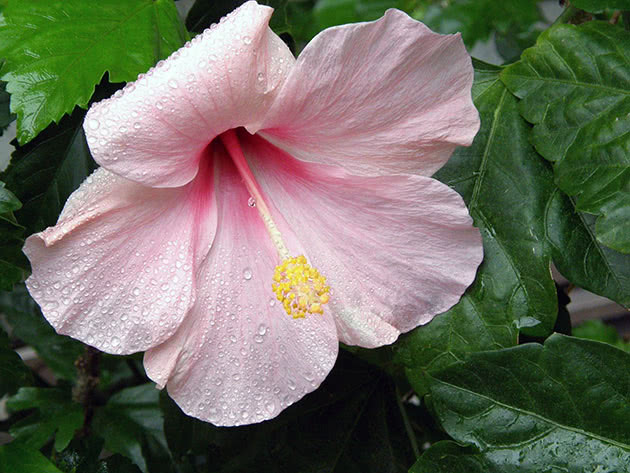
Pests and diseases of China rose
Harmful insects and diseases of China rose
The pests that are dangerous for China rose are thrips, aphids and spider mites. The invasion of these insects usually occurs as a result of not following the rules of care for the plant, and often the main reason is too dry air. Put a plant on a tray with wet stones, start spraying the leaves with sedimented water of a room temperature to eliminate favorable conditions for the life of these insects; to destroy the insects process the plant with an extract of hot pepper with soap twice with an interval of two weeks, and if contamination is too heavy, you will have to apply a solution of Actellic twice with an interval of two weeks at the rate of 15 drops per 35 fl oz.
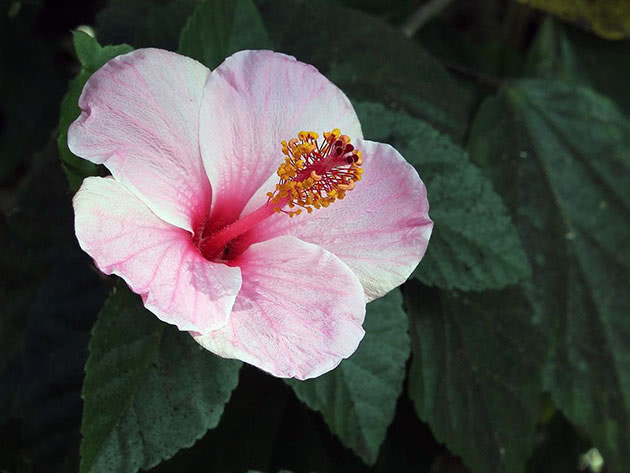
Sometimes, growers complain that the leaves of China rose turn yellow. This can be a disease such as chlorosis, occurring due to the high content of calcium and chloride in the water used for irrigation. Water must be sedimented and before watering you should add iron chelate in the water in the amount indicated in the instructions.
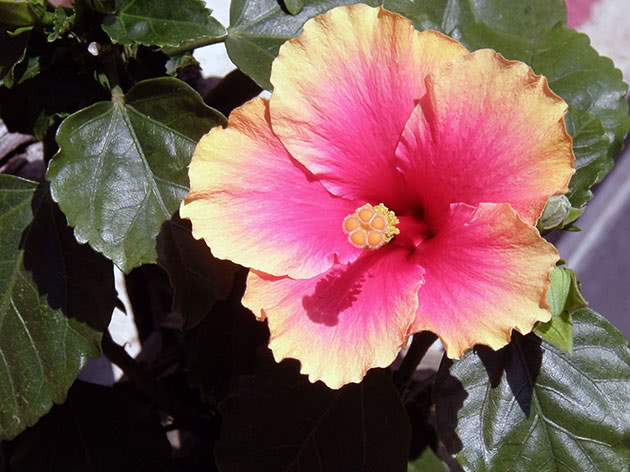
China rose turns yellow
If you water with sedimented water of the right temperature, but the leaves of your China rose still turn yellow, the reason of this may be too much moisture in the soil for a long time. If there are few yellow leaves, just reduce watering, you can even replace it by spraying the leaves at this time. But if there are lots of yellow leaves, it is necessary to transplant the plant into a new substrate, examining the roots and removing the rotten roots. Another reason why China rose turns yellow can be an insufficient light. In this case, there is a real leaf fall: leaves turn yellow and fall off in a large quantity.
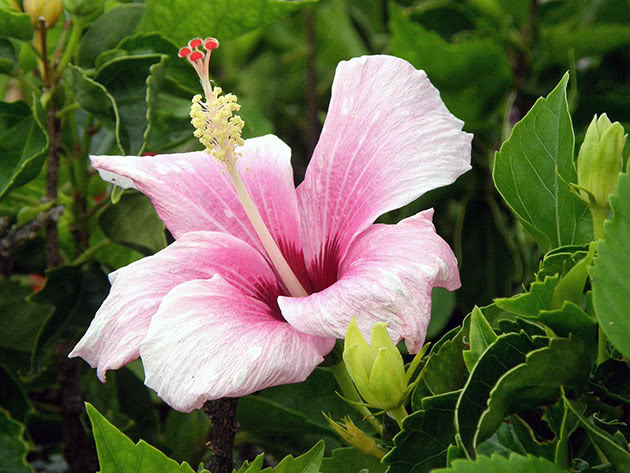
China rose sheds the leaves
The leaves of China rose fall off because of drafts and extreme changes of temperature. If you want to save the plant, immediately eliminate deficiencies in the care, it is quite easy. But do not worry if the plant sheds just a few leaves as for deciduous plants is quite normal.
China rose dries out
If you water the plant properly, and its leaves are still dry, it may be the reaction of the plant on the change of place. Also it can be caused by a loo low temperature. Give the plant some time to get over and keep it warm.

China rose withers
The reason can be an insufficient watering of the plant. Or it has not yet recovered from the transplantation. But the problem with the roots is the worst of all: gently clean the roots from the soil, soak them in a weak solution of potassium permanganate for half an hour and transplant in a small pot with a light soil (add vermiculite in the substrate for hibiscus). Probably these measures will save your plant.
China rose does not bloom
There are only a few reasons why China rose does not bloom, but most often it is due to an excess of nitrogen fertilizers in the soil, especially if the plant looks healthy with a rich foliage. The plant does not bloom also:
- if the light is not enough;
- if you do not water it enough during the active growing season;
- if in winter there is too high temperature in the room.
If you want your China rose to bloom, you need to eliminate these factors and fix other errors in the care for the plant.
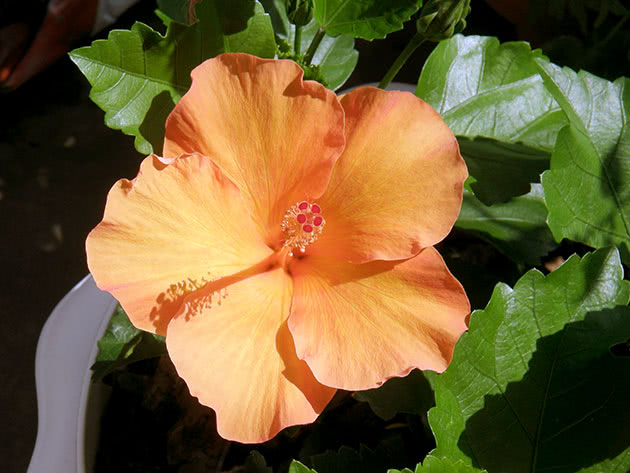
China rose: signs
Popularity of hibiscus sometimes serves a bad service to the plant: there are different stories about this flower, often they are mutually exclusive. For example, some sources claim that China rose attracts a lots of fans to the house where a woman lives in, while the others persistently warn against the destructive effects of hibiscus on the relationship between the couple. Some people believe that China rose is the flower of death and its late blooming predicts the death of the plant’s owner. And if China rose sheds the leaves, it means that someone from the house will get seriously sick very soon. However, quite often China rose is perceived as an attractive and unassuming houseplant without any negative meaning.
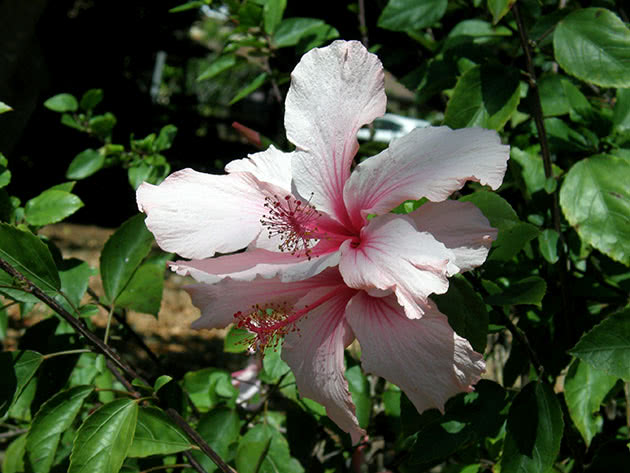
Where China rose can be kept at home
According to Feng Shui, the only rose that cannot be kept in the house is China rose because it has the ability to absorb energy. Believe it or not, but it is you who should decide it, but if you do not believe in signs, and you want to grow it in your home, who can stop you? Just do not place China rose in the bedroom or in the nursery, and keep this large plant in the living room where it will not be a hindrance, but it will rather serve as an excellent element of decor and clean your home air by absorbing harmful impurities and releasing oxygen.
